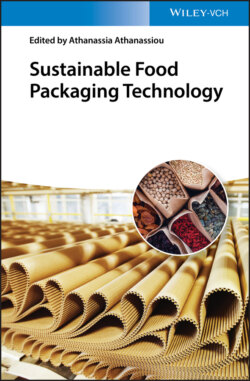Читать книгу Sustainable Food Packaging Technology - Группа авторов - Страница 24
1.3.9 Thermoplastic Starch
ОглавлениеStarch is a natural polysaccharide that can be obtained from a great variety of crops such as cassava and corn. It is considered as one of the most promising biopolymers for food packaging due to its availability, biodegradability, and low price [95]. Starch is composed of a mixture of two polymers, namely amylose and amylopectin. Amylose is a linear polysaccharide composed entirely of D‐glucose units joined by α‐1,4‐glycosidic linkages. Amylopectin is a branched‐chain polysaccharide composed of glucose units linked primarily by α‐1,4‐glycosidic bonds but with occasional α‐1,6‐glycosidic bonds, which are responsible for the branching. Relative percentages of amylose and amylopectin in starch are in the range 10–30% amylose and 70–90% amylopectin. The starch having a crystallinity between 20% and 40% is termed as semicrystalline in which the amorphous region of starch contains amylose and the branching points of amylopectin [96]. Native dry starch has a limited range of applications because of its high brittleness, high viscosity, retrogradation, insolubility in cold water, and poor melt processability because its Tg is probably above the decomposition point so it does not soften and flow [97]. BIOTEC® (Emmerich, Germany) has three product lines of TPS that include Bioplast® granules for injection molding, Bioflex® for film applications, and Biopur® as foamed starch [98]. In any case, films developed from native starch typically show moderate oxygen barrier properties but poor moisture barrier and mechanical properties, which limit their applications in food packaging [99].
Fortunately, starch can be modified by processing with plasticizers, grafting with vinyl monomers, and blending with other polymers. Plasticizers increase both the flexibility and processability of starch, which exhibits thermoplastic behavior and takes the name of TPS when plasticized by relatively low levels, in the 15–30 wt% range, of molecules that are capable of hydrogen bonding with the starch hydroxyl groups, mainly water, glycerol, and sorbitol. TPS can readily flow at elevated temperature and pressure and it can be extruded to give both foams or shaped into solid articles by injection molding. TPS products with different viscosity, water solubility, and water absorption have been prepared by altering the moisture/plasticizer content, amylose/amylopectin ratio of the raw material, and the temperature and pressure in the extruder [98]. A great deal of research has been performed on the plasticization of TPS using glycerol [100], sorbitol [101], urea or formamide [102], dimethyl sulfoxide [103], and low‐MW sugars [104]. Figure 1.6 shows different packaging articles obtained from starch, ranging from food trays to cups.
Unfortunately, the properties of neat TPS materials are not still good enough for most packaging applications. For example, the properties of films made of water‐ and glycerol‐plasticized TPS are poor at high humidity, present poor dimensional stability, and become brittle as water is lost. Fortunately, TPS can be blended with other polymers and fillers to improve the mechanical properties and also attained water resistance [105]. For instance, TPS/PLA blends show chemical resistance, improved flexibility and toughness, and low cost [106]. The use of TPS in biopolymer blends is particularly relevant to obtain materials with high elongation at break properties in food packaging [107].
Figure 1.6 Biodegradable packaging articles based on starch.
